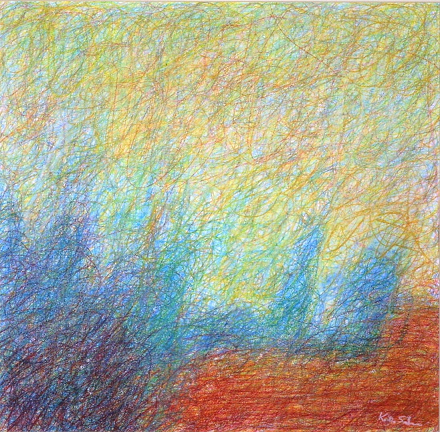
'Early Morning' - 2003
The realisation that I could still scribble was a huge turning point for me in the lengthy period of readjustment and re-learning I was doing after my sight started to deteriorate around 20 years ago. I had always loved drawing and see it as one of the fundamental basics behind all my artwork. Before the fuzzy eyes arrived my drawings varied enormously, from quite tight observational drawings usually of or planning for the sculpture I was then making, to loose and simple sketches done outside and more considered studio based pieces using a lot of colour. All of them though were dealing with one main issue, that of composition.
I can’t honestly say that I made the jump to scribble and more importantly organising scribble in a sudden moment of inspiration. I don’t think things really work like that. I can’t remember quite how the transition took place but I do know and remember distinctly doing the drawing ‘Early morning’ and realising immediately that I’d just gone a long way to confounding the visual impairment with regards to my efforts to continue creating half decent bits of art work again…
‘This was the first of my ‘organised scribbles’. I drew this after a particularly beautiful early morning walk through the countryside near Irvine. The low early sun was so bright that I could see very little, just the vague shapes of odd trees and shrubs amidst the summer grasses’.
This drawing was created using hard, water soluble pastels. The drawing is built up in layers of scribbled pastel line, starting with very light and pale colours and gradually developing the drawing using brighter and darker ones. Putting down the first few layers is a pretty soul destroying and time consuming task and one which I’m always grateful for having one of the RNIB talking book machines and a good book to listen too! Once through this stage, the interesting part starts, I can work out what’s happening and where I’m going with the drawing. For me, the great thing about working in this fashion was that I’d found a way of working that didn’t need much sight but that still had the appearance of being quite detailed.

'Riverside, evening'
These early drawings were nearly all based on the local Irvine landscape and townscape. The harbourside where my studio is situated is a wonderful place, changing in mood from hour to hour as the tides ebb and flow and the weather moves in off the Firth of Clyde. The light, just like in the hills, is constantly changing but it’ never dull …even on the dullest of days. It can be equally stunning on a day of gales and rain as on a beautiful summer’s day. It was then for a while the focus of many of my new drawings.
On The Hills
Of course by this stage I was walking the hills regularly and I started to turn my attention towards using these trips as the source for my work. At the time I couldn’t really figure out a way of doing paintings about these wild places. My early efforts were pretty dire to say the least. I was trying to paint them in a more traditional manner and had to use magnifiers to have some idea of what I was doing. This was a frustrating time for me as I realised that the hills were what I wanted to paint, but I just didn’t know how to go about it. The early attempts were trying to paint something that I didn’t actually see. Then I figured out that I needed to try and paint the fuzzy patterns and atmosphere as I now experienced the landscape..and what better way then to use my scribbled line to create this. So then, I started to scribble onto these paintings, creating a fine of veil on the surface of the paintings.

'From the slopes of Sgorr nam Fiannaidh, Glen Coe' 2004-2006
One of the first of these pieces was a largish painting that tried to capture the brief moment as the cloud broke while we were descending the upper slopes of Sgorr nam Fiannnaidh above Glencoe and Loch Leven. It wasn’t the complete answer but it did produce a painting that was much more about my experience of being in the hills. There was and still is, much to do in developing my ways of working, but the organised scribble and its move onto the paint surface was the starting point for much of the work I now do.

 Posted in
Posted in  Tags:
Tags: 